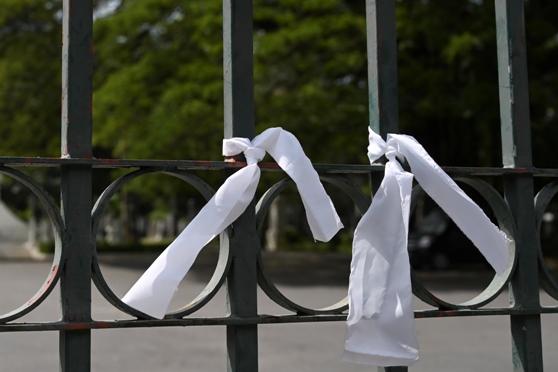Expert committee revises decision, recommends burial of COVID-19 dead with precautions
COLOMBO – The expert committee advising the government on the disposal of the Covid-dead has revised its stand and recommended that burial be permitted under strict conditions.
The health ministry which received the report, whose primary author is Senior Professor Jennifer Perera, is studying the new recommendations, informed sources said.
The four-page report gives strict guidelines for both processes, limiting the number of family members permitted to participate in funerals and strict guidelines for the location and nature of burial sites.
The report says the committee, which still believes cremation is the “most appropriate form of disposal of the body” had revised its stand to allow burials while adhering to specific guidelines based on new knowledge.
The committee report follows the reasoning presented by the College of Community Physicians of Sri Lanka (CCPSL) in a scientific position paper published on its website on Thursday (Dec 31) , in which it pointed out that in thousands of research papers published internationally there was no evidence of the transmission of the infection from a cadaver.
This brings the two most important colleges of experts in the fields to the same page.
Sri Lanka is one of only two countries of the world enforcing compulsory cremation which goes against the religious beliefs of adherents of the Abrahamic faiths, Judaism, Christianity and Islam. All other countries allow cremation or burial depending on the preferences of the family concerned.
Images of the unsigned report were tweeted by Journalists for Democracy in Sri Lanka (JDS) Friday (Jan 1) night and have now gone viral. JDS is a group of journalists exiled from Sri Lanka due to previous violence against them.
Pro-government academics and right-wing groups have argued that Muslims may take the bodies of Covid-dead and “weaponize” them and infect the general population. This was their justification to cremate all the cadavers of Covid dead.
Burying the bodies, they argued would contaminate the groundwater and further spread the disease.
As a result, many Muslim families have not claimed their dead and the government has resorted to storing the remains in freezer containers, which have been paid for by the Muslim community.
In the report, the panel said the SARS-CoV-2 virus infection is not a water-borne disease. “Contamination of water by the residual virus in a corpse leading into the water table through layers of soil to reach levels of the infectious dose is very remote as any residual infection virus continues to die. Furthermore, any residual infectious virus that reached the water table gets diluted in the large volume of water.”
It added that because of that factor the “amount of virus in water is insufficient to lead to an infection either by ingestion, contact with mucus membranes or through contaminated hands as the minimal infectious dose of the virus is quite high. For the same reasons, there also has been no evidence of transmission through water contamination from burial by SARS or influenza. However, water contamination could be avoided to a large extent by wrapping the body using virus impervious material such as non-biodegradable body bags.”
The recommendations of the panel:
– The dignity of the dead and their families should be respected and protected as far as possible throughout the process used for the disposal of the body.
– Only designated healthcare personnel should handle the corpses.
– The body should not be handed over to the relatives for cremation or burial.
-Ensure all those who interact with the body (the healthcare and mortuary staff) apply standard infection prevention and control (IPC) precautions. Continuous and adequate hand hygiene supplies, PPE, cleaning and disinfection supplies should be made available.
-The bodies for cremation or burial should not be embalmed.
-The cremation or burial should be carried out within 24 hours, once the order for disposal of the body is given.
-The body should be laid inside a double-layered body bag, prior to placing in the coffin. The body bags should be of 300 um thickness, padded with absorbent material, leak-proof and non-biodegradable.
– Viewing of the body will be permitted only within the healthcare facility/mortuary.
– If the family wishes to view the body, open/unzip the body bag and allow them to view the body at a one-meter distance wearing a mask and keeping a distance of one meter from each other. Touching the body or the belongings of the dead person is not permitted. The body should not be removed from the body bag for viewing.
– Only 4 persons from the family will be allowed to view the body. Two persons at a time should be allowed to view the body and a maximum period of 5 min/per two persons should be allowed for viewing the body under supervision. A total period of 10 min is allowed for viewing the body.
– When the body is transported to a crematorium/burial site by health authorities, a maximum of 4 persons from the family could be permitted to accompany the body in a separate mode of transport.
– The crematorium/burial site designated by the healthcare authorities should be used for disposal of the body.
-The coffin shall not be opened for any reason at the crematorium or the burial site.
– Allow 10 minutes for any religious activity under supervision at the crematorium/burial site prior to cremating/burying while observing social distancing and standard precautions. Only one religious dignitary and 4 persons from the family will be permitted to be present during the religious activity.
– The bottom of the grave should be 1.5 m from the ground surface and 1.2 m above the water table. The distance between the burial site and field drains should be 10 m minimum. The distance between burial site and drinking wells, boreholes, and wells should be 250 m minimum. The distance between the burial site and springs and watercourses should be 30 m minimum as per current recommendations by global experts.
-economynext.com


